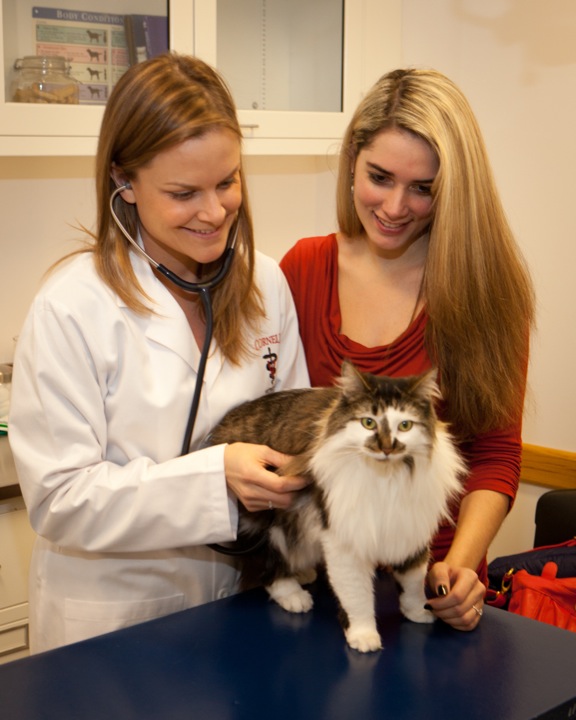Hypertrophic Cardiomyopathy (HCM)
Cause
 Hypertrophic cardiomyopathy (HCM) is the most commonly diagnosed cardiac disease in cats. Characterized by regional or diffuse thickening of the walls of the ventricle (the primary "pump" muscle of the heart), HCM has been diagnosed in cats as young as 4 months old and as old as 16 years old. Although the definitive cause of feline HCM has not been identified, its prevalence within certain breeds (i.e. Maine Coon cats, Ragdolls) has prompted speculation that at least some forms of HCM are genetic in origin. The finding of mutations in an important cardiac protein called myosin binding protein C in affected lines of Maine Coon and Ragdoll cats supports a heritable, genetic component of HCM in these breeds.
Hypertrophic cardiomyopathy (HCM) is the most commonly diagnosed cardiac disease in cats. Characterized by regional or diffuse thickening of the walls of the ventricle (the primary "pump" muscle of the heart), HCM has been diagnosed in cats as young as 4 months old and as old as 16 years old. Although the definitive cause of feline HCM has not been identified, its prevalence within certain breeds (i.e. Maine Coon cats, Ragdolls) has prompted speculation that at least some forms of HCM are genetic in origin. The finding of mutations in an important cardiac protein called myosin binding protein C in affected lines of Maine Coon and Ragdoll cats supports a heritable, genetic component of HCM in these breeds.
Thickening of the walls of the ventricle is associated with a decreased ventricular chamber volume and abnormal ventricular relaxation (diastolic function) in cats with HCM. Since the amount of blood pumped by the heart per minute (cardiac output) is the product of the amount of blood ejected per contraction (stroke volume) and the heart rate in beats per minute, this decreased chamber volume (and subsequent stroke volume) results in an increased heart rate (tachycardia) as a reflex mechanism to maintain cardiac output and blood pressure. Although this reflex increase in heart rate may maintain normal blood pressure in the short term, it is associated with an increased consumption of oxygen by the heart muscle, to the extent that oxygen demand may exceed supply. This scenario may result in an energy starved heart muscle, with subsequent heart cell death and worsening function. Another consequence of an increased heart rate is that the ventricle has less time to fill between contractions, further diminishing stroke volume and promoting a vicious cycle of reflex tachycardia, decreased time for ventricular filling, and so on. This decreased left ventricular filling also promotes stasis of blood in the left atrium (chamber just before the left ventricle), which ultimately contributes to the development of clinical signs (see below).
Clinical Signs
Many cats with HCM present without overt signs of illness. In other cases, signs of congestive heart failure including labored or rapid breathing, open-mouth breathing, and lethargy are evident. These signs occur when fluid accumulates in lung tissue (pulmonary edema) or around the lungs (pleural effusion) secondary to elevation of left atrial pressure. A potentially devastating cclud of HCM is thromboembolism. Thromboembolism refers to the development of a clot in the heart (promoted by left atrial enlargement), with ejection of the clot to the systemic circulation. When the clot lodges in the peripheral circulation, it may obstruct blood flow to the region of the heart supplied by the blocked vessel. The site of thromboembolism most commonly observed in cats with HCM is the distal aorta (termed a saddle thrombus), and clinical signs of hind limb paralysis and acute pain in the hind limbs may be observed. Thromboembolism is a poor prognostic indicator in cats with HCM.
Diagnosis
HCM is diagnosed by echocardiography, which shows the characteristic thickening of the left ventricular walls and decreased chamber volume of the left ventricle. Evaluation of the left atrium for dilation and/or the presence of a thrombus are also achieved using this modality. Since hyperthyroidism and hypertension may also cause left ventricular thickening, these diseases must be ruled out prior to arriving at a diagnosis of HCM. Thoracic radiography may be useful to evaluate pulmonary (lung) status and to rule out pleural effusion. Electrocardiography may be useful to characterize heart rate and to rule out cardiac arrhythmias.
Treatment
Treatment goals for feline HCM include controlling heart rate, alleviating pulmonary congestion, removing pleural fluid (if present), and decreasing the likelihood of thromboembolism. These goals are addressed by the administration of medications that may be delivered by injection in emergent situations or orally in more stable patients. Some drugs (i.e. nitroglycerine) may be applied to the skin for absorption.
Prognosis
The prognosis for cats with HCM is quite variable. Cats without clinical signs may survive for years, although the disease is most commonly progressive. Poor prognostic indicators include the presence of congestive heart failure, thromboembolism, and hypothermia (low body temperature). In spite of the fact that HCM may decrease the life span of affected cats (sometimes significantly so), medical therapy can improve the quality of life and longevity of cats affected with this common disease.


